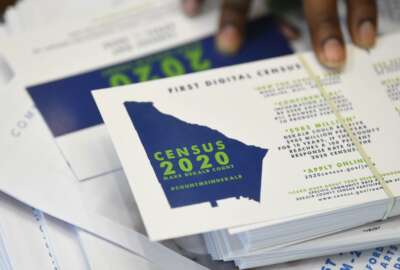Update: The Census Bureau announced March 28 it would suspend field operations until April 15.
Barely a week into the rollout of the 2020 Census, the Census Bureau has suspended all decennial hiring and onboarding until at least April 1, as part of its contingency planning amid the coronavirus pandemic.
The announcement by bureau officials in a call with reporters Friday comes just a few days after the bureau hit the brakes on its in-person fieldwork for the next two weeks.
Tim Olson, the bureau’s associate director for field operations, said the bureau, once it resumes hiring and onboarding, expects to hire more enumerators than it previously projected.
“We will be over-hiring in all areas once we resume the hiring process, really to accommodate for unexpected greater attrition. We’re still analyzing and crunching the numbers to see what that should be as far as the numbers of extra people to be higher,” Olson said.
The bureau previously expected it would need to hire up to 500,000 enumerators to complete the 2020 count.
“We are looking to see if we bring on larger numbers of people and start several weeks later, or a month later, what does that do in terms of our completion time. We’re currently studying and evaluating those things on a constant basis,” said Al Fontenot, the associate director for decennial census programs.
In cases where the bureau has already made job offers, Olson said the bureau has put a hold on follow-up steps, such as background checks and fingerprinting.
“It’s very possible, if not likely, that when it comes time to actually onboarding somebody into a job where they’re attending training and then beginning their work, there could be a greater loss of individuals out of fear or various reasons,” Olson said.
In the meantime, the public can continue to fill out census job applications online and complete the online assessment that comes with the application.
Fontenot said the bureau has been “adjusting on a day-to-day basis,” and held daily meetings to address changes in the field. Those changes include keeping in contact with officials from states such as California and New York, which have been hit hard by the pandemic.
Census officials, Fontenot added, have the same “critical services” classification that Postal Service employees have during the pandemic, but added that the bureau had no planned field operations in those states.
“We have two weeks to work with the local government there to determine exactly what the best course of action for each one of those operations will be,” he said.
California Gov. Gavin Newsom on Thursday ordered the state’s 40 million residents to stay home indefinitely, unless for essential work, errands and exercise.
Meanwhile, New York State has taken aggressive measures to contain and mitigate a cluster of COVID-19 cases in New Rochelle, New York, by ordered a quarantine of the area.
Fontenot said he has the authority to dip into a $2 billion contingency fund for the decennial count to make “any changes necessary.”
“We’ve been authorized to use funding in the contingency, where necessary, to accommodate the changes that we’re putting into the operation, and I control that budget,” he said. “We’ve focused on making sure we know where we need to apply that to accomplish any changes necessary to protect the health of our staff, to help protect the health of the people and to continue the mission.
The bureau will also push back non-response follow-up operations in most parts of the country to May 28.
Households will now have the option to self-respond to the decennial count online, over the phone, or through a paper questionnaire through Aug. 14.
While the bureau’s contingency planning allows some wiggle room for critical steps like non-response follow up, it also faces a constitutional mandate to send the decennial count data to Congress and the president by Dec. 31.
Census public information chief Michael Cook said the bureau remains “laser-focused” on meeting that deadline.
The bureau continues to evaluate how it will “maintain a minimum operation” at paper questionnaire processing centers in Phoenix, Arizona, and Jeffersonville, Indiana while ensuring the health and safety of its employees, Fontenot said.
Fontenot said the bureau’s contingency planning would allow one of the two facilities to operate on one shift and still meet its workflow.
But in the event of further setbacks and delays, he said both facilities could operate on two-to-three shifts in a shorter timeframe and still keep up with the volume of completed paper questionnaires.
“Of course, that’s dependent on what type of delay we’re talking about, but right now that could accommodate a fairly long delay,” Fontenot said.
As of Friday morning, the bureau has received responses from 18.6 million households.
Prior to the suspension of field operations, enumerators had dropped off questionnaire packets in Puerto Rico, and tribal and rural since March 15. The hand delivery of census forms impacts less than 5% of the country’s population. This operation is on pause until at least March 29.
Meanwhile, the bureau has suspended all in-person interviews for non-decennial surveys, such as the annual American Community Survey, opting instead for all-phone interviews.
Copyright
© 2024 Federal News Network. All rights reserved. This website is not intended for users located within the European Economic Area.
